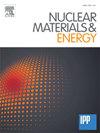利用深度学习算法研究托卡马克中氢同位素发射的谱线
IF 2.7
2区 物理与天体物理
Q1 NUCLEAR SCIENCE & TECHNOLOGY
引用次数: 0
摘要
人工智能(AI)越来越多地应用于各种等离子体物理主题,包括在光谱学和磁约束聚变等离子体诊断中的应用。本文研究了卷积神经网络(CNN)算法在磁融合装置分流区发射光谱中的应用。具体来说,我们使用CNN从氢-氘(HD)等离子体的Balmer-α谱线的理论发射光谱中确定氢同位素比率。将人工智能与光谱学相结合的动机是开发新的框架,使其在准确性、速度或适应性方面优于现有的基于光谱线拟合的经典方法。在之前的工作中,我们使用了一个全连接神经网络算法来计算托卡马克中与分流等离子体相关的条件(磁场、中性温度、馏分和氢浓度)下HD等离子体发射的理论h - α/ d - α线谱。对生成的光谱进行预处理,提取少量的光谱特征作为神经网络的输入数据。在本研究中,我们首次将CNN模型应用于HD等离子体理论上发射的原始合成Hα/Dα谱,以预测相应的同位素比率。在这种情况下,我们表明训练后的CNN预测的氢同位素比与真实值的偏差高达5%。此外,我们的模型可以将其预测推广到相对于磁场的任何观测角度对应的光谱,尽管仅对来自平行观测的光谱进行训练。这些情况下的预测精度与训练精度相当。本文章由计算机程序翻译,如有差异,请以英文原文为准。
Study of line spectra emitted by hydrogen isotopes in tokamaks through Deep-Learning algorithms
Artificial Intelligence (AI) is increasingly used in various plasma physics topics, including applications in spectroscopy and diagnostics in magnetically confined fusion plasmas. The paper focuses on the application of the convolutional neural network (CNN) algorithm to emission spectroscopy from the divertor regions of magnetic fusion devices. Specifically, we use a CNN to determine hydrogen isotopic ratios from the theoretical emission spectra of the Balmer-α line in hydrogen–deuterium (HD) plasmas. The motivation for coupling AI with spectroscopy is to develop novel frameworks that can outperform existing classical methods based on spectral line fitting, in terms of accuracy, speed, or adaptability. In a previous work, we have used a fully connected neural network algorithm for theoretical Hα/Dα line spectra emitted by HD plasmas which have been generated for conditions relevant to divertor plasmas in tokamaks (magnetic field, neutral temperatures and fractions and hydrogen concentration). The generated spectra were preprocessed to extract few spectroscopic features which were then used as input data by the neural network. In the present work, we apply for the first time a CNN model to raw synthetic Hα/Dα line spectra theoretically emitted by HD plasmas to predict the corresponding isotopic ratios. In this context, we show that the trained CNN predicts hydrogen isotopic ratios with deviations of up to 5% from the true values. Additionally, our model can generalize its predictions to spectra corresponding to any observation angle relative to the magnetic field, despite being trained solely on spectra from parallel observations. The prediction accuracy in these cases is comparable to the training accuracy.
求助全文
通过发布文献求助,成功后即可免费获取论文全文。
去求助
来源期刊

Nuclear Materials and Energy
Materials Science-Materials Science (miscellaneous)
CiteScore
3.70
自引率
15.40%
发文量
175
审稿时长
20 weeks
期刊介绍:
The open-access journal Nuclear Materials and Energy is devoted to the growing field of research for material application in the production of nuclear energy. Nuclear Materials and Energy publishes original research articles of up to 6 pages in length.
 求助内容:
求助内容: 应助结果提醒方式:
应助结果提醒方式:


